Shanghai Ghetto
The Shanghai Ghetto, formally known as the Restricted Sector for Stateless Refugees, was an area of approximately one square mile in the Hongkew district of Japanese-occupied Shanghai (the southern Hongkou and southwestern Yangpu districts of modern Shanghai). The area included the community around the Ohel Moshe Synagogue but about 23,000 of the city's Jewish refugees were restricted or relocated to the area from 1941 to 1945[1] by the Proclamation Concerning Restriction of Residence and Business of Stateless Refugees. It was one of the poorest and most crowded areas of the city. Local Jewish families and American Jewish charities aided them with shelter, food, and clothing.[1] The Japanese authorities increasingly stepped up restrictions, but the ghetto was not walled, and the local Chinese residents, whose living conditions were often as bad, did not leave.[2][3]
| Shanghai Ghetto | |||||||||
|---|---|---|---|---|---|---|---|---|---|
 Seward Road in the ghetto in 1943 | |||||||||
| Chinese name | |||||||||
| Traditional Chinese | 上海難民營 | ||||||||
| |||||||||
| Restricted Sector for Stateless Refugees | |||||||||
| Traditional Chinese | 無國籍難民限定地區 | ||||||||
| Simplified Chinese | 无国籍难民限定地区 | ||||||||
| |||||||||
| Japanese name | |||||||||
| Kanji | 無国籍難民限定地区 | ||||||||
Background
Jews in 1930s Germany
At the end of the 1920s, most German Jews were loyal to Germany, assimilated and relatively prosperous. They served in the German army and contributed to every field of German science, business and culture. After the Nazis were elected to power in 1933, the state-sponsored anti-Semitic persecution such as the Nuremberg Laws (1935) and the Kristallnacht (1938) drove masses of German Jews to seek asylum abroad, with over 304,500 German Jews choosing to emigrate, 1933-1939.[4] Chaim Weizmann wrote in 1936, "The world seemed to be divided into two parts—those places where the Jews could not live and those where they could not enter."[5]
The Evian Conference demonstrated that by the end of the 1930s it was almost impossible to find a destination open for Jewish immigration.
According to Dana Janklowicz-Mann:
Jewish men were being picked up and put into concentration camps. They were told you have X amount of time to leave—two weeks, a month—if you can find a country that will take you. Outside, their wives and friends were struggling to get a passport, a visa, anything to help them get out. But embassies were closing their doors all over, and countries, including the United States, were closing their borders. ... It started as a rumor in Vienna... ‘There's a place you can go where you don't need a visa. They have free entry.’ It just spread like fire and whoever could, went for it.[6]
Shanghai after 1937
The International Settlement of Shanghai was established by the Treaty of Nanking. Police, jurisdiction and passport control were implemented by the foreign autonomous board. Under the Unequal Treaties between China and European countries, visas were only required to book tickets departing from Europe.
Following the Battle of Shanghai in 1937, the city was occupied by the army of Imperial Japan, and the port began to allow entry without visa or passport. By the time when most German Jews arrived, two other Jewish communities had already settled in the city: the wealthy Baghdadi Jews, including the Kadoorie and Sassoon families, and the Russian Jews. The last ones fled the Russian Empire because of anti-Semitic pogroms pushed by the tsarist regime and counter-revolutionary armies as well as the class struggle manifested by the Bolsheviks. They had formed the Russian community in Harbin, then the Russian community in Shanghai.
Chiune Sugihara, Jan Zwartendijk and Tadeusz Romer
Many in the Polish-Lithuanian Jewish community were saved by Chiune Sugihara, the Japanese consul in Kaunas, Lithuania, and Jan Zwartendijk, director of the Philips manufacturing plants in Lithuania and part-time acting consul of the Dutch government-in-exile. The refugees fled across the vast territory of Russia by train to Vladivostok and then by boat to Kobe in Japan. The refugees, totaling 2,185, arrived in Japan from August 1940 to June 1941.
Tadeusz Romer, the Polish ambassador in Tokyo, had managed to get transit visas in Japan, asylum visas to Canada, Australia, New Zealand, Burma, immigration certificates to Palestine, and immigrant visas to the United States and some Latin American countries. Tadeusz Romer moved to Shanghai on November 1, 1941, where he continued to act for Jewish refugees.[7] Among those saved in the Shanghai Ghetto were leaders and students of Mir yeshiva, the only yeshiva in occupied Europe to survive the Holocaust.
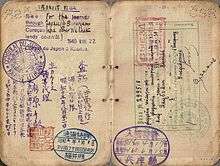
Arrival of Ashkenazi Jews
The refugees who managed to purchase tickets for luxurious Italian and Japanese cruise steamships departing from Genoa later described their three-week journey with plenty of food and entertainment—between persecution in Germany and squalid ghetto in Shanghai—as surreal. Some passengers attempted to make unscheduled departures in Egypt, hoping to smuggle themselves into the British Mandate of Palestine.
The first German Jewish refugees—twenty-six families, among them five well-known physicians—had already arrived in Shanghai by November 1933. By the spring of 1934, there were reportedly eighty refugee physicians, surgeons, and dentists in China.
On August 15, 1938, the first Jewish refugees from Anschluss Austria arrived by Italian ship. Most of the refugees arrived after Kristallnacht. During the refugee flight to Shanghai between November 1938 and June 1941, the total number of arrivals by sea and land has been estimated at 1,374 in 1938; 12,089 in 1939; 1,988 in 1940; and 4,000 in 1941.[8]
In 1939-1940, Lloyd Triestino ran a sort of "ferry service" between Italy and Shanghai, bringing in thousands of refugees a month - Germans, Austrians, and a few Czechs. Added to this mix were approximately 1,000 Polish Jews in 1941.[9] Among these were the entire faculty of the Mir Yeshiva, some 400 in number, who with the outbreak of World War II in 1939, fled from Mir to Vilna and then to Keidan, Lithuania. In late 1940, they obtained visas from Chiune Sugihara, the Japanese consul in Kaunas, to travel from Keidan, then Lithuanian SSR, via Siberia and Vladivostok to Kobe, Japan.[10] By November 1941 the Japanese moved this group and most of others on to the Shanghai Ghetto in order to consolidate the Jews under their control.[11] Finally, a wave of more than 18,000 Ashkenazi Jews from Germany, Austria, and Poland immigrated to Shanghai; that ended with the Attack on Pearl Harbor by Japan in December 1941.[12]
The Ohel Moshe Synagogue served as a religious center for the Russian Jewish community since 1907; it is currently the Shanghai Jewish Refugees Museum. In April 1941, a modern Ashkenazic Jewish synagogue was built (called the New Synagogue).[13]
Much-needed aid was provided by International Committee for European Immigrants (IC), established by Victor Sassoon and Paul Komor, a Hungarian businessman, and the Committee for the Assistance of European Jewish Refugees (CFA), founded by Horace Kadoorie, under the direction of Michael Speelman. These organizations prepared the housing in Hongkou, a relatively cheap suburb compared with the Shanghai International Settlement or the Shanghai French Concession. Refugees were accommodated in shabby apartments and six camps in a former school. The Japanese occupiers of Shanghai regarded German Jews as "stateless persons",[14] after the Japanese government decided Jewish exclusion did not match the spirit of racial equality.
Life in the restricted sector
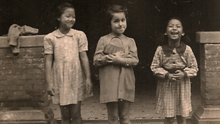
The authorities were unprepared for massive immigration and the arriving refugees faced harsh conditions in the impoverished Hongkou District: 10 per room, near-starvation, disastrous sanitation, and scant employment.
The Baghdadis and later the American Jewish Joint Distribution Committee (JDC) provided some assistance with the housing and food problems. Faced with language barriers, extreme poverty, rampant disease, and isolation, the refugees still were able to transition from being supported by welfare agencies to establishing a functioning community. Jewish cultural life flourished: schools were established, newspapers were published, theaters produced plays, sports teams participated in training and competitions, and even cabarets thrived.[15]
There is evidence that some Jewish men married Chinese women in Shanghai. Although not numerous, “the fact that interracial marriages were able to take place among the relatively conservative Jewish communities demonstrated the considerable degree of cultural interaction between the Jews and the Chinese” in Shanghai.[16]
After Pearl Harbor (1941–1943)
After Japanese forces attacked Pearl Harbor, the wealthy Baghdadi Jews (many of whom were British subjects) were interned, and American charitable funds ceased. As communication with the US was banned and broken, unemployment and inflation intensified, and times got harder for the refugees.
The JDC liaison Laura Margolis, who came to Shanghai, attempted to stabilize the situation by getting permission from the Japanese authorities to continue her fundraising effort, turning for assistance to the Russian Jews who arrived before 1937 and were exempt from the new restrictions.[17][18]
German requests, 1942-1944
During a trial in Germany relating to the Shanghai Ghetto, Fritz Wiedemann reported that Josef Meisinger had told him that he got the order from Himmler to persuade the Japanese to take measures against the Jews. According to Wiedemann, Meisinger certainly could not have done this in form of a command to the Japanese.
Since most Japanese were not anti-Semitic, Meisinger used their fear of espionage to achieve his goal. In fall 1942 he conferred with the head of the foreign section of the Japanese Home Ministry. Meisinger explained, that he had order from Berlin to give the Japanese authorities all names of "anti-Nazis" among the German community. He explained that "anti-Nazis" were primarily German Jews, of whom 20,000 had emigrated to Shanghai. These "anti-Nazis" were always "anti-Japanese" too.
Later a subordinate, the interpreter of Meisinger, Karl Hamel, reported to CIC agents, that the Japanese, after some consideration, believed in this thesis. According to Hamel, this led to a veritable chase of "anti-Nazis" and to the internment of many people. In response, the Japanese demanded from Meisinger to compile a list of all "anti-Nazis." As his personal secretary later confirmed, this list had already been prepared by Meisinger in 1941. After consultation of General Müller in Berlin, it was handed over by Meisinger to the Japanese Home Ministry and to the Kenpeitai at the end of 1942.
The list contained the names of all Jews with a German passport in Japan. For the Japanese this official document made clear, that in particular the large number of refugees, who had fled to Shanghai from 1937 onwards, represented the highest "risk potential". So the proclamation of a ghetto was just a logical consequence of Meisinger's intervention. This way Meisinger succeeded, despite the barely existing anti-Semitism of the Japanese, to achieve his goal: The internment of a large part of the Jews in the Japanese sphere of influence. Apparently for this "success" he was promoted Colonel of the police on February 6, 1943, despite the Richard Sorge affair. These informations were kept secret by US authorities and were not used in civil proceedings of ghetto inmates to gain redress. That is why, for example in the case of a woman who was interned in the ghetto, a German court came to the conclusion, that even though there was a probability that Meisinger tried to encourage the Japanese to take action against Jews, the establishment of the ghetto in Shanghai was "solely based on Japanese initiative".[19]
On November 15, 1942, the idea of a restricted ghetto was approved, which was after the visit of Shanghai by Meisinger.
As World War II intensified, the Nazis stepped up pressure on Japan to hand over the Shanghai Jews. While the Nazis regarded their Japanese allies as "Honorary Aryans", they were determined that the Final Solution to the Jewish Question also be applied to the Jews in Shanghai. Warren Kozak describes the episode when the Japanese military governor of the city sent for the Jewish community leaders. The delegation included Amshinover rabbi Shimon Sholom Kalish. The Japanese governor was curious and asked "Why do the Germans hate you so much?"
Without hesitation and knowing the fate of his community hung on his answer, Reb Kalish told the translator (in Yiddish): "Zugim weil wir senen orientalim—Tell him [the Germans hate us] because we are Orientals." The governor, whose face had been stern throughout the confrontation, broke into a slight smile. In spite of the military alliance, he did not accede to the German demand and the Shanghai Jews were never handed over.[20]
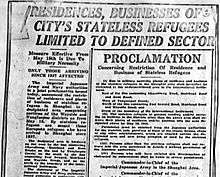
According to another rabbi who was present there, Reb Kalish' answer was "They hate us because we are short and dark-haired." Orientalim was not likely to have been said because the word is an Israeli academic term in modern Hebrew, not a word in classical Yiddish or Hebrew.
Creation of the Shanghai Ghetto
On February 18, 1943, the occupying Japanese authorities declared a "Designated Area for Stateless Refugees" and ordered those who arrived after 1937 to move their residences and businesses within it by May 18, three months later. The stateless refugees needed permission from the Japanese to dispose of their property; others needed permission to move into the ghetto.[2] About 18,000 Jews were forced to relocate to a 3/4 square mile area of Shanghai's Hongkou district, where many lived in group homes called "Heime" or "Little Vienna".[21]
The English version of the order read:
The designated area is bordered on the west by the line connecting Chaoufoong, Muirhead, and Dent Roads; on the east by Yangtzepoo Creek; on the south by the line connecting East Seward, Muirhead, and Wayside Roads; and on the North by the boundary of the International Settlement.[24]
While this area was not walled or surrounded with barbed wire, it was patrolled and a curfew enforced in its precincts. Food was rationed, and everyone needed passes to enter or leave the ghetto.[2]
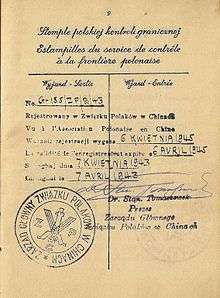
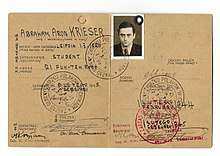
According to Dr. David Kranzler,
Thus, about half of the approximately 16,000 refugees, who had overcome great obstacles and had found a means of livelihood and residence outside the 'designated area' were forced to leave their homes and businesses for a second time and to relocate into a crowded, squalid area of less than one square mile with its own population of an estimated 100,000 Chinese and 8,000 refugees.[25]
Although a few temporary passes were issued to work and to 16 students of St. Francis Xavier College, outside the ghetto, these were granted arbitrarily and were severely curtailed after the first year. But the fact that the Chinese who lived within the Hongkou ghetto did not leave meant the Jews were not isolated. Nevertheless, economic conditions worsened; psychological adjustment to ghettoization was difficult; the winter of 1943 was severe and hunger was widespread.[3]
The US air raids on Shanghai began in 1944. There were no bomb shelters in Hongkou because the water table was close to the surface. The most devastating raid started on July 17, 1945, and was the first attack that hit Hongkou. Thirty-eight refugees and hundreds of Chinese were killed in the 17 July raid.[26]
The bombings by the US 7th Air Force continued daily until early August, when the atomic bomb was dropped on Hiroshima and the Japanese government surrendered shortly thereafter.Refugees in the ghetto, improvised their own shelters, with one family surviving the bombing under a bed with a second mattress on top, mounted on two desks.
Some Jews of the Shanghai ghetto took part in the resistance movement. They participated in an underground network to obtain and circulate information and were involved in some minor sabotage and in providing assistance to downed Allied aircrews.[3]
After liberation
The ghetto was officially liberated on September 3, 1945, after some delay to allow Chiang Kai-shek's army to take political credit for the liberation of Shanghai. With the establishment of the State of Israel in 1948 and the fall of Chiang Kai-shek in 1949, almost all the Shanghai ghetto Jews left. By 1957, only 100 remained; today only a few may still live there.[3]
The Government of Israel bestowed the honor of the Righteous Among the Nations to Chiune Sugihara in 1985 and to Ho Feng Shan in 2001.
Since the establishment of diplomatic relations between Israel and China in 1992, the connection between the Jewish people and Shanghai has been recognised in various ways. In 2007, the Israeli consulate-general in Shanghai donated 660,000 Yuan, provided by 26 Israeli companies, to community projects in Hongkou District, in recognition of the safe harbour provided by the ghetto.[27] The only Jewish monument in Shanghai is located at Huoshan Park (formerly Rabin Park) in Hongkou District.[28]
Partial list of notable refugees in the Restricted Sector for Stateless Refugees
- Aaron Avshalomov, Russian composer.
- Abba Berman, Haredi rabbi, Rosh yeshiva.
- Charles K. Bliss, whose Chinese experience inspired him to create Blissymbols.
- W. Michael Blumenthal, served as the U.S. Treasury Secretary.
- Morris Cohen, known by his nickname Two-Gun Cohen, he served as bodyguard and aide-de-camp to Sun Yat-sen, eventually becoming a Chinese general.
- Shaul Eisenberg, who founded and ran the Eisenberg Group of Companies in Israel.
- Kurt Rudolf Fischer, professor at University of Pennsylvania and University of Vienna.
- Gunther Gassenheimer, rabbi, Temple Israel, Alameda, CA.
- Eduard Glass, Austrian chess master.
- Eric Halpern, a cofounder of the Far Eastern Economic Review and its first editor.
- Zev "Velvel" Gordon, served as Rabbi and Dayan in Toronto for 50 years.
- Peter Haas, U.S. Army Officer, and Business Executive.
- Leo Hanin, leader of Shanghai Betar.
- Otto Joachim, German composer.
- Shimon Sholom Kalish, Hasidic rebbe of Amshinov–Otvotsk.
- Yisrael Mendel Kaplan, Haredi rabbi, served as Reb Mendel.
- Yechezkel Levenstein, Haredi rabbi, served as Mashgiach Ruchani.
- Francis Mankiewicz, Canadian film director, screenwriter and producer.
- Peter Max, American pop artist.
- Lotte Lustig Marcus, psychologist in Carmel, California.
- Michael Medavoy, a Hollywood executive at Columbia, Orion and TriStar Pictures.
- Rene Rivkin, Australian financier.
- Jakob Rosenfeld, more commonly known as General Luo, who spent nine years overseeing health care and who served as the Minister of Health in the 1947 Provisional Communist Military Government of China under Mao Zedong.
- Hermann Schieberth, a Society photographer in Vienna
- Reb Yeshaya Shimanowitz, Haredi rabbi, served as rabbi in RJJ.
- Otto Schnepp, professor at University of Southern California
- Chaim Leib Shmuelevitz, Haredi rabbi, served as Rosh yeshiva of the Mirrer Yeshiva in Shanghai (1941–1947), and in Jerusalem (1965–1979).
- John G. Stoessinger, Distinguished Professor of Global Diplomacy at the University of San Diego
- Stephan Sulke, Swiss musician.
- George Szekeres, professor of mathematics, University of New South Wales.
- Frank Theeman, Australian property developer
- Laurence Tribe, professor, Harvard Law School, Carl M. Loeb University Professor [29]
- George Zames, a control theorist and professor at McGill University, Montreal, Quebec.
See also
- Abraham Kaufman, a prominent Zionist in China
- An Investigation of Global Policy with the Yamato Race as Nucleus (1943)
- History of the Jews in China & Japan
- Jewish settlement in the Japanese Empire
- MS St. Louis (1939)
- Fugu Plan, a Japanese plan to bring Jewish refugees to Manchukuo (1934, 1938)
Films
- Empire of the Sun. 154 min. 1987.
- A Jewish Girl in Shanghai. 80 min. 2010.
- The Port of Last Resort: Zuflucht in Shanghai. Documentary directed by Joan Grossman and Paul Rosdy.
- Shanghai Ghetto. Documentary by Dana Janklowicz-Mann and Amir Mann.
- Ye Shanghai. 62 min. Film and live audio-visual performance by Roberto Paci Dalò created in Shanghai in 2012. Commissioned by Massimo Torrigiani for SH Contemporary - Shanghai Contemporary Art Fair and produced by Davide Quadrio and Francesca Girelli.
References
- Shanghai Jewish History Archived 2010-05-29 at the Wayback Machine (Shanghai Jewish Center)
- Shanghai Ghetto Shows a Hidden Piece of WWII History Archived 2011-06-04 at the Wayback Machine By Kimberly Chun (AsianWeek)
- The Jews of Shanghai: The War Years Archived 2005-03-08 at the Wayback Machine, Murray Frost.
- "The Jews of Germany". The Museum of the Jewish People at Beit Hatfutsot.
- Manchester Guardian, May 23, 1936, cited in A.J. Sherman, Island Refuge, Britain and the Refugees from the Third Reich, 1933–1939, (London, Elek Books Ltd, 1973), p.112, also in The Evian Conference — Hitler's Green Light for Genocide Archived 2013-08-27 at the Wayback Machine by Annette Shaw
- Europe's Harms to China's Arms by Sally Ogle Davis and Ivor Davis (Jewish Journal) October 4, 2002
- [Krzysztof Kacperek]. "Kanadyjska Fundacja Dziedzictwa Polsko-Żydowskiego - Tadeusza Romera Pomoc Żydom Polskim na Dalekim Wschodzie". Polish-jewish-heritage.org. Retrieved 2011-07-08.
- "Avraham Altman and Irene Eber. Flight to Shanghai, 1938-1940: The Larger Setting. p.2/32" (PDF). Retrieved 2011-07-08.
- "Anthony Hughes. Sport and Jewish identity in the Shanghai Jewish Community 1938-1949" (PDF). Retrieved 2011-07-08.
- Shanghai Jewish History Archived August 13, 2006, at the Wayback Machine
- "Pamela Shatzkes. Kobe: A Japanese haven for Jewish refugees, 1940–1941. Japan Forum, 1469-932X, Volume 3, Issue 2, 1991, pp. 257–273". Cite journal requires
|journal=(help) - "Return of a Shanghai Jew". Latimes.com. 2006-01-15. Retrieved 2011-07-08.
- Ember, Melvin; Ember, Carol R.; Skoggard, Ian (2004-11-30). Encyclopedia of Diasporas. Immigrant and Refugee Cultures Around the World. Vol. I, Jewish Diaspora in China by Xu Xin, p.157, Ember, Melvin; Ember, Carol R.; Skoggard, Ian (Eds.), Springer 2004, ISBN 0-306-48321-1. ISBN 9780306483219. Retrieved 2011-07-08.
- "Péter Vámos. The Life of Central European Jewish Refugees in Shanghai During World War II. University of San Francisco. Pacific Rim Report No. 23, November 2001". Pacificrim.usfca.edu. Archived from the original on 2010-06-26. Retrieved 2011-07-08.
- The Ghosts of Shanghai by Ron Gluckman
- Zhou Qingyang, “Interactions Between the Chinese and the Jewish Refugees in Shanghai During World War II,” Penn History Review 25(2), 2018, 50–88 (68).
- Special Tributes. Laura Margolis, Rescuer of Jews Archived 2006-10-12 at the Wayback Machine A Testimonial by Ernest G. Heppner, Author of Interactions Between the Chinese and the Jewish Refugees in Shanghai During World War II Refuge: A Memoir of the World War II Jewish Ghetto
- "Forgotten Heroes of the Holocaust". Kimel.net. Retrieved 2011-07-08.
- Jochem (2017), pp. 82–95.
- The Rabbi of 84th Street: The Extraordinary Life of Haskel Besser by Warren Kozak (HarperCollins, 2004) ISBN 0-06-051101-X p.177
- "Feature: Former Jewish refugees revisit Shanghai Ark". English.people.com.cn. 2005-11-11. Retrieved 2011-07-08.
- "Hongkou, der Ghettobezirk in Shanghai" [Hongkou, the Ghetto District in Shanghai] (in German). 2001. Archived from the original on 6 February 2002. Retrieved 15 January 2015.
- French, Paul (2010). The Old Shanghai: A–Z. Hong Kong: Hong Kong University Press. ISBN 9789888028894.
- English decree cited by Exil Shanghai;[22] modern forms of the old street names according to French.[23]
- Japanese, Nazis and Jews: The Jewish Refugee Community in Shanghai, 1938–1945 by David Kranzler, p.491.
- Voticky, Anka (2010). Knocking on every door. Toronto: The Azrieli Foundation. p. Kindle loc 1299–1317. ISBN 978-1-897470-20-6.
- China News Agency. 2006-06-07 以色列企业捐款上海 感谢二战时接纳犹太难民 (Israeli companies donate to Shanghai - gratitude for accepting Jewish refugees in World War II). People's Daily. Accessed 2006-06-07
- "One Day Private Shanghai Jewish Culture Tour" (PDF). Archived from the original (PDF) on 2011-01-15. Retrieved 2011-07-08.
- Lattman, Peter (2006-12-12). "Law Blog - WSJ.com : Law Blog Flashback: Larry Tribe and Pennzoil v. Texaco". Blogs.wsj.com. Retrieved 2011-07-08.
Further reading
- Betta, Chiara. "From Orientals to Imagined Britons: Baghdadi Jews in Shanghai." Modern Asian Studies 37#4 (2003): 999-1023.
- Falbaum, Berl, ed. Shanghai Remembered...Stories of Jews Who Escaped to Shanghai from Nazi Europe (Momentum Books, 2005) ISBN 1-879094-73-8, ISBN 978-1-879094-73-4
- Heppner, Ernest G. Shanghai Refuge: A Memoir of the World War II Jewish Ghetto (Lincoln:coln University of Nebraska Press: 1993). ISBN 0803223684, ISBN 0803272812
- Jochem, Clemens (2017). Der Fall Foerster: Die deutsch-japanische Maschinenfabrik in Tokio und das Jüdische Hilfskomitee. Berlin: Hentrich & Hentrich. ISBN 978-3-95565-225-8.
- Kranzler, David. Japanese, Nazis & Jews: The Jewish Refugee Community of Shanghai, 1938-1945 (Yeshiva University Press: 1976).
- Malek, Roman. From Kaifeng--to Shanghai: Jews in China (Steyler Verlag, 2000).
- Ristaino, Marcia Reynders. Port of Last Resort: The Diaspora Communities of Shanghai (Stanford University Press, 2001) ISBN 978-0-8047-5023-3
- Ross, James R. Escape to Shanghai: A Jewish Community in China (The Free Press, 1994) ISBN 0-02-927375-7
- Strobin, Deborah and Ilie Wacs An Uncommon Journey: From Vienna to Shanghai to America—A Brother and Sister Escape to Freedom During World War II (Barricade Books, 2011) ISBN 1-56980-452-4
- Tobias, Sigmund. Strange Haven: A Jewish Childhood in Wartime Shanghai (University of Illinois Press, 1999) ISBN 0-252-02453-2
- Ten Green Bottles (book): The True Story of One Family's Journey from War-torn Austria to the Ghettos of Shanghai by Vivian Jeanette Kaplan (St. Martin's Press, 2004) ISBN 0-312-33054-5
- To Wear the Dust of War : From Bialystok to Shanghai to the Promised Land, an Oral History by Samuel Iwry, Leslie J.H. Kelley (Editor) (Palgrave Studies in Oral History. Palgrave Macmillan, 2004) ISBN 1-4039-6576-5
- Tokayer, Rabbi Marvin (1979). "The Fugu Plan." New York: Weatherhill, Inc.
- Maruyama, Naoki (2005). "Pacific War and Jewish Refugees in Shanghai."(Japanese) Tokyo: Hosei Univ. Press.
- Survival in Shanghai: The Journals of Fred Marcus 1939-49 by Audrey Friedman Marcus and Rena Krasno (Pacific View Press, 2008) ISBN 978-1-881896-29-6
- Far from Where? Jewish Journeys from Shanghai to Australia by Antonia Finnane (Melbourne University Press, 1999) ISBN 0-522-84846-X
- Cafe Jause: A Story of Viennese Shanghai by Wena Poon (Sutajio Wena, 2015) ISBN 1502549085
- Voticky, Anka (2010). Knocking on every door. Toronto: The Azrieli Foundation. ISBN 978-1-897470-20-6.
- Love and Luck: The story of Jewish Shanghai Ghetto resident, Eva Levi written by her daughter, Karen Levi.
External links
- Shanghai Jews
- "Refuge in Shanghai (1938-1953)" American Jewish Joint Distribution Committee Archives
- Jewish Voice of the Far East = Juedisches Nachrichtenblatt der Juedischen Gemeinde mitteleuropaeischer Juden in Shanghai is a digitized periodical at the Leo Baeck Institute
- Medizinische Monatshefte Shanghai = Shanghai medical monthly is a digitized periodical at the Leo Baeck Institute
- Mitteilungen der Vereinigung der Emigranten-Aerzte in Shanghai (China) is a digitized periodical at the Leo Baeck Institute